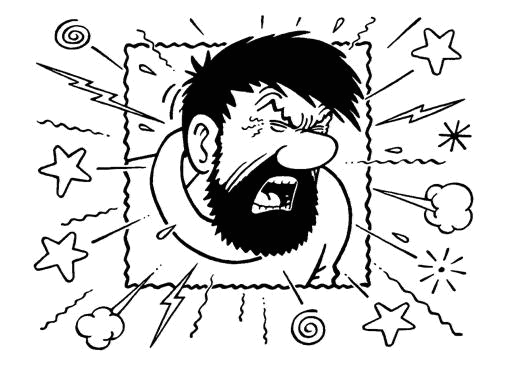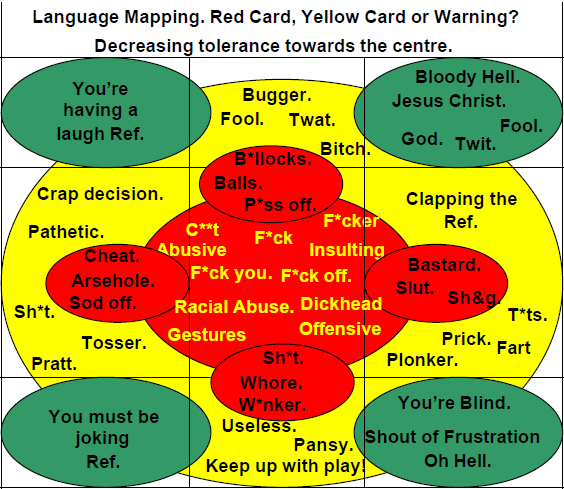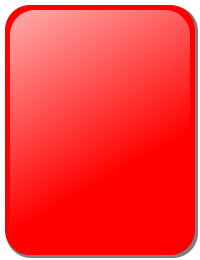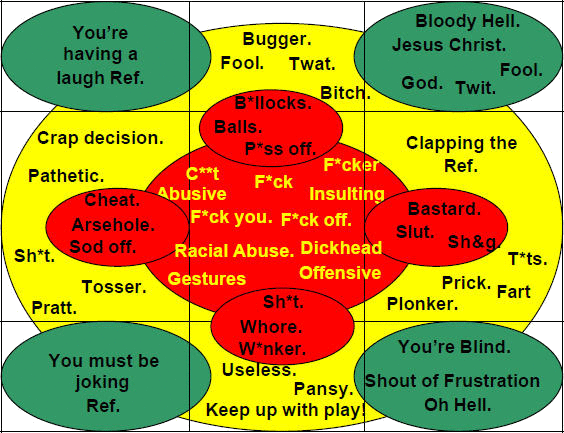| |
 |
BAD LANGUAGE MAPPING
Identify and deal with…
Julian Carosi
The Corsham Referee
 |
Guide to Bad Language for Soccer Referees

Although Referees in general are not comfortable with the more
demonstrative expressions and moaning that have always been part of
nearly every football match, Referees are expected to tolerate it to a
certain degree, provided that it keeps within the bounds of decency, and
does no violence to fundamental norms. However, this attitude does not
satisfy the purists, whose aim is to rid the game completely of all
forms of dissent, or at least, to understandably rein it back to a more
acceptable level. Whilst these sentiments are laudable, the attraction
of football has (and always
will have) an element of feistiness' that makes it such an exciting
sport. To tolerate something, is to approve it. Therefore, it is only
when the conduct offends the Referee, that he needs exercise his
toleration, by taking some form of disciplinary action.
On the whole, society has accepted that dissent and bad language is part
of the game of football, and a single Referee attempting to start a
crusade all on his own to rid the game of bad language, will fail
dismally unless he has the full backing of the Football Association and
all other Referees. Every now and then, however, we wake up to the fact
that although bad language and dissent has been normalized, it is not
normal in other forms of society and sport. Whilst our tolerance
acceptance does not eliminate our sense that there must be alternatives
to controlling
bad language, it would require a mutual commitment by all the
participants of the game, to increase levels of behavior, particularly
the players and managers. It is interesting to note, that the more
polite that Referees have become, the worse the level of behavior
becomes. Hence there is a conflict for some Referees, on how best they
can balance the Laws as they are written, against the need to officiate
using a level of tolerance. Punishment for specifically using bad (foul)
language was taken out of the Laws of Association Football in season
1997/1998, following a complete rewrite of the Laws. The wording of the
sending -off offence was changed from 'uses foul or abusive
language', to 'uses offensive, insulting or abusive language'.
Due to the accepted increase and tolerance of foul language in general
society, it was deemed by the International Football Association Board (IFAB)
that foul language alone, was no longer
to be automatically punished with a sending off, but that it now
expected Referees to judge when the words actually constituted (or
contributed to) an offence or not. In other words, it is not the words
alone that create an offence in this more tolerant society, but both the
words used AND the ambience in which they are delivered and meant.
This stance was not unexpected, as Referees had for many years previous
to 1997/1998 season, already applied their own understanding of the
(foul language) Law. In other words, it was generally only when foul
language was delivered in an abusive, insulting or offensive
manner, that the red card
was used.
Anyone who watches a game of football at any level, appreciates that it
would be impossible for a Referee to play 90 minutes, if he was mandated
to send off every player who used foul language. Hence, the change in
the Laws brought in a level of realism to reflect the changes in
society. The Referee is now expected to interpret what is required of
him in respect of foul language, without actually being given any
guidelines from the authority that changed the Law! This is not unusual
in the world of Refereeing, as the Laws are written in such a way that
it allows the Referee a huge
amount of leeway in how to interpret them - rather than applying them as
they are written in black and white. The Law change from 'uses
foul or abusive language', to 'uses offensive, insulting or abusive
language', has generally been a success in Refereeing terms, as
the sport of football continues to expand its following. But there is a
danger that as the tolerance of bad language in society increases, at
what level will the Laws have to be changed once again? Only time will
tell - in the meantime, the Referee will continue to be judge and jury,
in terms of what is acceptable and what is not at the level in which he
officiates.
It must be emphasized here, that whilst Referees are expected to strive
towards consistency in terms of the level of foul language they allow,
they do not actually condone its use. Referees are placed in an awkward
position. They are criticized by those who want players to be "Saints"
on the field of play, and criticized by others when they send off
players for... 'offensive, insulting or abusive language'.
It is a no win situation for Referees. The difficulty is more prevalent
in youth football, where the Referee is expected to also educate young
players by sensible application
of the Laws. Yet, very often, it's the managers, coaches and parents who
are the instigators of bad language and exhibitors of bad habits as far
as their protégées are concerned. But one thing is for certain, it is
the Referee (and the Football Association) that is at the forefront of
trying to bring respect back into the game. It is a very difficult
balance to achieve for the men in black, who are governed by the Laws on
one side, and a changing (and a more tolerant) society on the other
side. The only reasonable guideline that a Referee can use, is to adhere
to the level of tolerance
used in his locality, or in the league in which he officiates. There is
little point in an individual Referee embarking on a crusade to curb bad
language by overly strict application of the Laws, as this will
ostracizes him from the footballing
community. A Referee who feels strongly about the slipping standards of
ba d language usage, can achieve better results by being proactive
rather than reactive. In other words, as soon as bad language
materializes, the Referee can use strong man-management skills to curb
it at the onset. This is particularly a very useful method to use in
Youth football, where nobody wants to see the Referee continuously
stopping play to admonish players for bad language every minute or so!
In short, a Referee who is proactive in attempting to deal with bad
language, is more accepted, than the Referee who reacts by sending off
perpetrators, without attempting to make any effort to curb
it on the first place!
One of the greatest problems to beset Referees, is the popularity and
coverage of football on television, where bad language is
sensationalized by television companies who zoom in and virtually
translate the lip movements of irate players. The difficulty that
Referees have at the lower levels, is how to enforce the Laws that seem
to be ignored at the top levels. This is a subject that will be aired
for many years to come. But a Referee at the lower levels should take
his steer from the Law book, and the interpretations and methods used at
his level, and not what is seen (and
supposedly accepted) in televised games. To do otherwise, will only
create more problems for him, in his sphere of practice at the lower
levels.
From season 1997/1998 onwards, it is important for Referees to
distinguish 'bad language' (e.g. foul language), from 'offensive,
insulting or abusive language'. Foul language is no longer banned in the
modern Laws.
The reasoning behind this, is the fact that swear words (foul language)
are unfortunately part of the common vocabulary of many people. It would
therefore be unreasonable to expect players who use such language in
their day -to-day lives, when speaking to their friends and families, to
be expected to clean up their language when they are in the fierce
intensity of a game of football. It is the language that is intended to
insult or offend, or to provoke, that referees are now asked to punish
in accordance with the Laws. It is not the Referees' job to try and
covert society to become monks! The Referees job is to apply the Laws,
and punish the language that is intended to insult or offend, or to
provoke. Standards of behavior in public have been falling steadily and
good manners and common decency are less evident. This is a fact that
cannot be ignored. For example: A Player who says, "that was not a f***ing
penalty Ref.," , is likely to receive a less severe reaction from the
Referee, compared to a player who says, "Ref., you are a f***ing c***!"
Law 12 (Fouls and Misconduct) does not include a definitive listing of
what constitutes offensive or insulting or abusive language; or dissent.
Some of the words in the Bad Language Mapping image above, are 'foul
language'; words; but when they are used as part of conversation on the
field of play, they are not necessarily illegal as far as the Laws are
concerned. They only become illegal, if the context in which they are
being used, becomes 'offensive, insulting or abusive' in any way. This
is an important concept for Referees to grasp. It is possible for even
the most vilest of swear
words to be vocally delivered in a such a way as not to seem offensive.
Conversely, it is also possible for a non-offensive word to be vocally
delivered in such a way as to seem offensive! Therefore, Referees need
to get away from the concept that such words as, "F***ing hell", or
"boll**ks" are always going to be punished with a red card.
One of the greatest difficulties for a Referee to learn - is how to
interpret the following two
points of Law: Law 12: Sending Off Offence: - A player is shown the red
card if he uses, offensive
or insulting or abusive
language, and/or gestures.
Law 12: A player is cautioned and shown the yellow card if he shows
dissent by word or action.
You have probably heard mentioned, that "Every Referee has their own
tolerance level" and will only
react to bad language or dissent when this level has been breached. This
is only partly true. If
Referees only relied
on the ‘Letter of the Law’ in respect of the Law 12 rulings above, then
the number of players
remaining on
the field of play would quickly reduce to a level that would leave the
Referee no choice but to
abandon almost every game.
Therefore, a Referee's individual tolerance levels do have
an important
part to play.
The 17 Laws of Associated Football (LOAF) are very simple, yet
conversely complicated to enforce.
Thankfully, Referees are not expected to be ‘Robots in Shorts’, and are
given a huge amount of
discretion within the Laws to inject some realism.
Referees are human beings, capable of using a balance of common sense,
experience and
interpretation as well as Law knowledge when officiating in games. The
Referee is not just a
'policeman' who blows his
whistle every time one of the players makes a comment - he is
(thankfully) allowed to interpret
each situation
sensibly - this ensures that the game 'flows' properly, and is allowed
to continue when it can.
The difficulty arises when calls of inconsistency are leveled towards
Referees.
For example, if a player says to a Referee.
“Keep up with play Ref.!”
One Referee may decide to show a yellow card and caution this player.
Another Referee hearing the
same words in another game may decide that a strong warning to the
player would suffice. And in
another game, if the same words are said to the Referee in a joking sort
way, then that Referee
might just smile and join in
the fun!
Yes, this is inconsistency as far as the actual words themselves are
concerned - but that is of
little concern. Because it is not the words themselves that constitute
offensive or insulting or
abusive language. The human voice is capable of projecting a huge range
of emotions using the same
words. Factors that
determine the severity of vocal words are numerous, and can be affected
by a player's temper,
loudness and direction of voice, tone, the eyes, facial and body
language to name but a few. It is
therefore possible for even the most vilest of swear words to be vocally
delivered in a such a way
as not to seem offensive. Conversely, it is also possible for a non
-offensive word to be vocally
delivered in a such a way as to seem offensive!
It is more important for Referees to be consistent in the way they deal
with instances where the
"ambience of the words" are against the ‘spirit of the game’ rather than
trying to be consistent in
relation to just the words themselves.
Words on their own are not so easy to categorize into neat areas such as
offensive, insulting,
abusive or dissenting listings. As human beings, each Referee will react
differently to verbal
stimulation!
A Referee does not automatically discipline every player who uses bad
language. The Laws of Soccer allow the Referee to make a judgment based on the whole environment
surrounding the delivery of the words.
It may be that the words constitute a touch of humor.
It may be that the words are an innocent act of frustration on the
player's part after he has
missed an "open goal".
It may be that the words are offensive.
It may be a million other things.
It is not the words themselves taken in isolation that constitute an
offence. In other words, the
Laws allow the Referee to make a judgment using common sense, which
could result in no punishment
being administered by him; a sending-off; a strong warning or maybe a
caution as an alternative
punishment.
(The only exception to this, are words of racial connotation. These
should always be punished
properly, irrespective of how they are delivered).
Note: It is also possible for certain words to be more readily accepted
in one country but not so
readily accepted in another. Therefore, it would be impossible to have a
global listing of easily
punishable words. For example - the biggest no-no in American baseball
games: You absolutely
cannot call the umpire a "cock-sucker". It doesn't matter whether it was
screamed or mumbled,
doesn't matter whether there were children present, doesn't matter what
play action has just
transpired. If you call the umpire a "cock-sucker", you are out of the
game (irrespective of the
ambience of how the words were delivered).
(Thanks to Marissa for the pertinent note above).
The Language Mapping diagram will give Referees a starting point, in
trying to understand the
differences between issuing a Red card, a Yellow card, or giving a
verbal warning to players who
use bad language or show dissent. The main message of the Language
Mapping Venn diagram is that
there is no definitive listing of where each word should appear in the
map.
It is not just that word itself that should be the sole measurement of
what is bad language and
what is not.
The inner Red oval contains words and word-types that Law 12 state could
be dealt with by the issue
of a
Red card.
But once again - it is not so much the words themselves that count; it
is the ambience that they
carry when delivered.
For example:
(a) Were they loud?
(b) Were they directed at the Referee?
(c) Were they uttered in frustration after the player missed an open goal?
(d) Were they said in an angry way?
(e) Are there young children nearby?
(f) Are they threatening? (g) Are they racial?
(h) Does an angry facial expression accompany them?
(i) Where they meant as humor?
There are many more examples……………
Each Referee must learn by experience, the nuances of what is deemed to
be unacceptable language.
The outer Yellow oval contains words that Law 12 state could be deemed
to be dissent, and punished
by the issue of a Yellow card.
But yet again - it is not so much the words themselves that count, it is
the ambience that they
carry when delivered. For example, were the words directed at the
Referee or one of his Assistants,
and did they question the Referees’ decision? Or were they said in
frustration?
The four small Orange ovals that are positioned partly on the inner Red
oval, and partly over the
outer Yellow oval, contain words that could either be dealt with by the
issue of a Yellow card for
dissent, or by the issue of a Red card – depending on other factors.
(For example, were they
abusive or were they said in a
dissenting fashion?)
There are four Green ovals that are positioned at each corner of the
diagram, partly over the outer Yellow oval, and partly outside of the
diagram. These contain words (and phrases) that could either be dealt
with by the issue of a Yellow card for dissent, or by the issue of a
verbal warning to the player – depending on other factors. (For example,
were they said in frustration, or in a joking way, or were they really
meant?)
The aim of the Language Mapping diagram is not to offer Referees a category listing of:
(a) Red card words.
(b) Yellow card words.
(c) A listing of words that constitute a verbal warning.
(d) A list of words that can be ignored
The Language Mapping Venn diagram demonstrates that the same word (or
words) could fit into any of
the categories above. There is no definitive listing of words that
constitute a sending off or a
caution for dissent or a verbal warning.
Each Referee will need to continually adjust the pallet of colors in
the Language Mapping diagram
to fit
each ‘bad language’ incident as it arises. And this can only be done by
not restricting yourself
to a dedicated listing of categorized words.
Law 12 does not have a definitive listing of what constitutes offensive
or insulting or abusive
language. Or dissent.
Therefore, Referees need to get away from the concept that "F*ck You" is
a red card; "Crap
decision" is a yellow card; and "You must be joking Ref" is a warning.
There is a little more to
it than that!
93% of interpersonal communication is not what is being said. Scientific
analysis has determined
that in person-to-person communication:
 -
Words convey 7% of the message
-
Words convey 7% of the message
 -
Intonation, pitch and pace of speech convey 38%
-
Intonation, pitch and pace of speech convey 38%
 -
Vibes, body movements, gestures, facial expressions convey 55% .
-
Vibes, body movements, gestures, facial expressions convey 55% .
Tolerance Levels for Controlling Bad Language
In Season 1997 -1998, the wording of Law 12 was changed. The sending-off
offence of: "Foul and Abusive Language"" was replaced by: "Using
Offensive, Insulting or Abusive language". This change meant that the
individual Referee on the day, can now decide what is 'offensive' or
'insulting'. Because of human nature, every individual Referee has his
own tolerance level as far as bad language is concerned.
FIFA gave the following as the reason for this change: A player may now
be sent off if, in the opinion of the referee, he is guilty of using
language or gestures, which are offensive or insulting or abusive. The
referee must take into account the severity of the offence. He continues
to have the authority to decide whether, in his opinion, a player's
unacceptable language or gestures are to be deemed a sending off
offence.
This allows the Referee the option of cautioning a player for unsporting
behavior or dissent, as appropriate, if, in the Referee's opinion, the
offence committed is not serious enough for the Referee to award a
sending off.
On top of this, each country, and each region, and each competition also
has its own different in -built tolerance level that has developed, and
established itself over the years. It is no wonder that new Referees
have difficulty in knowing when to send a player off, when to award a
yellow card, or when to give a public warning when bad language is used.
To help understand this difference in tolerance levels, and to help
Referees appreciate what is expected of them, please see the advice below:
| The Levels of Tolerance |
 |
In the above image, Level 0 (Zero) Tolerance, shown at the red (left)
end of the spectrum, is where a Referee officiates by using no common
sense, no interpretation, and in complete and total accordance with the
Laws of the Game.
A Referee who officiates in this manner, will have a complete dominating
control over the players, and will be seen as a unwelcome dictator. If a
player so much as says, "Bloody Hell Ref!", the red card will be flashed
in an instant. This type of Referee is also known as the 'Law Book on
Legs'. He will be the most unpopular Referee around, and his services
will inevitably not be required in the future by the players or the
Football Association.
Conversely, a Referee who officiates at the right (green) end of the
tolerance spectrum, at tolerance level 10, is the type of Referee who
has no interest in applying the Law, ignores all bad language, and
generally allows the players to dictate how the game progresses. He does
not have a tolerance level - he lets everything go. If a player says,
"F%^&*ng Hell Ref!", the Referee will probably respond along the lines
of; "I hope they do for your sake mate!".
This type of Referee is known as the 'The 'Plonker''. At first, he will
be seen as the players' friend 'Mr Plonker', but as soon as there is any
trouble to sort out, he will be re-christened, by substituting the first
3 letters of his name with 'WA'
He will be the second most unpopular
Referee around, and his services will inevitably not be required by the
players or the Football Association.
Therefore..............the tolerance level for an efficient Referee must
lay somewhere between Level 0 (zero)
and Level 10 (ten).
The optimum level will be anything between tolerance levels 3 and 7.
Refereeing within these levels
ensures that that the Referee uses the Laws in conjunction with common
sense and proper
interpretation of
situations. For example, a player who swears in frustration ("F%^&*ng
Hell Ref!") because he has
just missed an open goal, can be treated differently to the same player
saying the same words, but
directed towards the Referee, after the Referee has awarded a decision
against this player.
("F%^&*ng Hell Ref!") If the bad language is directed at the Referee or
at another person, and is
made with intense anger or with
the intent to demean, disrespect, or incite the other person, then a
sending off is warranted. If a
player uses bad language in a momentary display of anger or temper
against himself, then a caution
(or a strong warning) might be considered as an appropriate punishment.
The Referee must aim to
keep players on the field of play, and not to look for clauses in the
Law that can be used to expel
players.
There are more ways than one in dealing with bad language. A strong
public verbal warning is a good
starting point when a player has only slightly stepped across the line.
Inform the player that
although his language was not directed at any other person, it is still
unacceptable as far as the
Laws of the Game are concerned. Make it clear to the player, that if he
continues to use such
language, it may result in a stricter sanction. Taking this action every
early in the game, is a
very good way for a Referee to stamp his authority on a game, and it
gives the players a strong
message, that bad language will not be tolerated.
Varying the tolerance levels in a game is also another useful way to
manage players. For example,
if the game starts of 'fast and furious', and players are more
interested on kicking lumps out of
each other, rather than playing the ball - the Referee should use
tolerance level 3, or even 2. Do
not allow any advantage, apply the Laws more strictly, and stop play for
every little foul. And
publicly warn every player (or caution if necessary) when they use bad
language. A Referee needs to
show that he is the one who is controlling the game, and that he is not
willing to 'share' control
with the players. If the players cannot accept his control, then he must
'boss' the game.
As soon as the players get the message and start playing football, the
Referee can ease off his
strict management, and move up a few steps to tolerance levels 5, 6 and
7, where he can let the
game flow as much as he can.
Question: So how can a Referee decide which tolerance level to begin with?
Answer: There is no
text-book answer. But...................
A Referee who strongly believes that EVERY player who uses bad language,
should receive a red card,
will be unable to last very long without the backing of his Football
Association. A single Referee,
on a personal crusade to clean up the game, will end up antagonizing the
players and being offered... ZERO appointments.
An ambitious Referee, will correctly adjust his tolerance level, to suit
the league he is
officiating in. For example, a Sunday morning 'Parks' Referee at the
beginning of his career, will
not use the same tolerance levels used by the top Referees in the
English Premiership, professional
football league. It would not work.
There is a simple solution to this complex question. To progress up the
ladder, a Referee has to do what is expected of him, at the level at
which he officiates. If he attempts to Referee in a manner completely
alien to what is expected at his local level, then he is a fool! A
successful Referee will spend time looking at games at his level, and
gauging what is expected as far as tolerance levels are concerned, and
then apply it to his performance.
He can then concentrate on the other things that he is good at - without
fear of becoming a martyr!
“Ignore what needs to be ignored, and hear what needs to be heard.”

<«--- Vary your tolerance within levels 3 and 7 ---»>
Julian Carosi
The Document:
|

